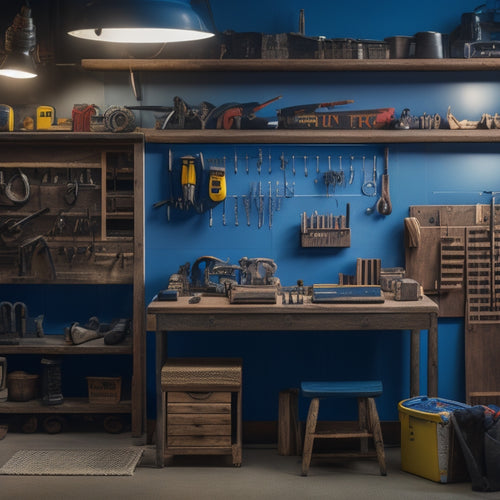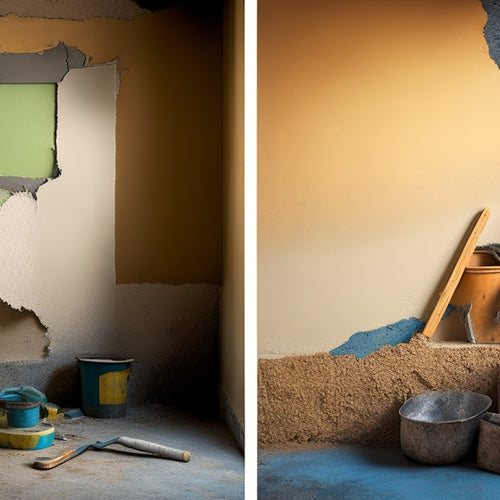
5 Buckets to Get for a Successful Renovation
Share
You'll need a mix of buckets to cover all aspects of your renovation. Start with a sturdy, reliable mixing bucket for concrete, featuring measurement markings and non-slip handles. A heavy-duty bucket with a capacity of 20-50 gallons is essential for large projects. For smaller tasks, a 1-5 gallon bucket provides flexibility and precision. Consider a specialty bucket for unique needs, such as underwater pouring, and don't forget must-have accessories like lids and liners. With these five buckets, you'll be well-equipped to tackle your renovation - and understanding their features and benefits will guarantee you get the most out of them.
Key Takeaways
• Invest in a sturdy, reliable mixing bucket with measurement markings for accurate mixing ratios and a non-slip handle for safety.
• Choose a heavy-duty bucket with a capacity of 20-50 gallons for large-scale renovations, featuring robust materials and reinforced handles.
• Select a smaller bucket with a capacity of 1-5 gallons for precise mixing and control in smaller projects, ideal for circular mixing techniques.
• Consider specialty buckets designed for unique needs, such as underwater pouring, with ergonomic designs, insulation, and anti-slip handles.
• Don't forget essential accessories like bucket lids, liners, and anti-slip coatings to prevent spills, corrosion, and accidents during renovations.
Essential Mixing Buckets for Concrete
When preparing to mix concrete, you'll need a sturdy, reliable bucket that can withstand the rigors of repeated use and harsh materials. A high-quality mixing bucket is essential for achieving accurate mixing ratios, which are critical for strong and durable concrete.
Look for buckets made from heavy-duty materials like steel or thick, impact-resistant plastic. These materials can handle the weight and abrasion of concrete, guaranteeing your bucket lasts through multiple projects.
A bucket with measurement markings can help you accurately measure and mix your concrete. Additionally, consider a bucket with a non-slip handle or grip to prevent accidents and injuries. A bucket with a wide, sturdy base will also reduce the risk of tipping or spilling.
When choosing a mixing bucket, prioritize durability, safety, and ease of use. By investing in a high-quality bucket, you'll be able to achieve consistent, high-quality concrete mixes and guarantee a successful renovation project.
Heavy-Duty Buckets for Large Projects
How do you guarantee your mixing buckets keep up with the demands of large-scale renovation projects?
For starters, you need heavy-duty buckets made from robust materials that can withstand the rigors of intense use. Look for buckets constructed from thick, high-quality plastics or metals that can resist cracks and punctures.
A critical factor to take into account is bucket capacity – you'll need buckets that can hold a substantial amount of concrete or other materials to keep your project moving efficiently. Opt for buckets with capacities ranging from 20 to 50 gallons or more, depending on the scope of your project.
Additionally, make sure your buckets have sturdy handles that can support the weight of the contents and facilitate safe lifting and pouring. Heavy-duty buckets with reinforced handles and rims will give you the confidence to tackle large projects without worrying about your equipment failing.
Buckets for Smaller Concrete Tasks
For smaller concrete tasks, you'll need buckets that offer flexibility and precision, allowing you to mix and pour smaller amounts of concrete with ease.
These small project buckets are ideal for tasks like repairing cracks in walls, creating small concrete pads, or pouring tiny foundations. When choosing a bucket for smaller concrete tasks, look for ones with a capacity of 1-5 gallons. This size range allows for precise mixing and pouring, reducing waste and mess.
When working with smaller amounts of concrete, it's important to use the right concrete mixing techniques. Start by mixing the concrete in small batches, using a ratio of 1 part cement to 2 parts sand and 3 parts aggregate.
Mix the ingredients in a circular motion, gradually adding water until you achieve the desired consistency. Use a trowel or mixing stick to scrape the sides and bottom of the bucket, ensuring all ingredients are well combined.
With the right bucket and concrete mixing techniques, you'll be able to tackle smaller concrete tasks with confidence and precision.
Specialty Buckets for Unique Needs
You'll need specialty buckets designed for unique applications, such as pouring concrete underwater or in extreme temperatures, to tackle complex renovation projects that require extra durability and adaptability. These buckets are built to withstand harsh conditions and guarantee your project's success.
For instance, buckets with specialty sizes can help you pour concrete in tight spaces or reach high areas. Look for ergonomic designs that reduce fatigue and improve handling, allowing you to work efficiently and safely.
When working in extreme temperatures, choose buckets with insulation or thermal protection to prevent concrete from freezing or overheating. Some specialty buckets also feature anti-slip handles, reinforced rims, or reinforced materials for added strength and durability.
Additionally, consider buckets with built-in mixing paddles or agitators to simplify the mixing process. By investing in the right specialty bucket for your unique needs, you'll be better equipped to handle complex renovation projects and guarantee a successful outcome.
Must-Have Accessories for Buckets
Equipping your buckets with the right accessories can greatly enhance their performance and make your renovation project more efficient.
You'll want to contemplate investing in bucket lids to prevent spills and messes. These lids are especially useful when transporting liquids or loose materials, ensuring they stay contained and don't create a hazard.
Additionally, bucket liners are a must-have for protecting your buckets from corrosion and damage. They're particularly useful when working with harsh chemicals or abrasive materials that can compromise the integrity of your buckets.
When choosing bucket lids and liners, make sure they're durable and compatible with your bucket type. Look for lids with secure fastening systems and liners that are resistant to punctures and tears.
You may also want to contemplate liners with anti-slip coatings to prevent accidents.
Frequently Asked Questions
How Often Should I Clean and Maintain My Buckets?
You should clean and maintain your buckets regularly to guarantee they remain safe and functional.
Establish a maintenance schedule to inspect your buckets daily, cleaning them after each use and performing a deep clean weekly.
This bucket care routine will prevent damage, corrosion, and contamination.
Set reminders to stay on track, and make adjustments as needed.
Can I Use Plastic Buckets for Mixing Epoxy or Resin?
When working with epoxy or resin, you should avoid using plastic buckets for mixing. These materials can react with plastic, causing contamination and affecting the final result.
Instead, opt for stainless steel or fiberglass buckets specifically designed for epoxy mixing techniques and resin application tips. These materials won't react with the chemicals, ensuring a safe and successful application.
Always prioritize safety and use the right tools to avoid costly mistakes.
Are Metal Buckets Safe for Mixing Harsh Chemicals?
You might think metal buckets are a good choice for mixing harsh chemicals, but beware - they can spark chemical reactions that put you at risk.
In reality, metal buckets can react with certain chemicals, causing unwanted reactions or even explosions.
When working with harsh chemicals, it's essential to choose bucket materials that won't compromise your safety.
Opt for inert materials like stainless steel, glass, or polypropylene to guarantee a safe mixing process.
Can I Use a Bucket for Both Mixing and Applying Materials?
When you're planning a renovation, you might wonder if you can use a bucket for both mixing and applying materials. The answer is, it depends.
If you're using a dedicated bucket for mixing harsh chemicals, it's best to keep it separate from application to avoid cross-contamination.
However, if you're using a clean bucket with safe materials, you can use it for both mixing and applying.
Just be certain to follow proper mixing techniques and clean the bucket thoroughly between uses to guarantee a safe and successful project.
How Do I Properly Store Buckets When Not in Use?
When you're not using your buckets, you'll want to store them safely to prevent accidents and prolong their lifespan.
You should clean and dry your buckets thoroughly before storing them in a designated area.
Invest in bucket organization systems, such as stackable crates or hooks, to keep them off the floor and prevent tripping hazards.
Consider storage solutions like shelving units or cabinets with secure lids to protect your buckets from dust and damage.
Conclusion
As you stand amidst the renovation chaos, surrounded by dust and debris, remember that the right buckets can be the unsung heroes of your project.
With these five essential buckets by your side, you'll be mixing, hauling, and finishing like a pro.
Imagine the satisfying thud of concrete pouring into a sturdy bucket, the sound of progress being made.
With the right tools, your vision takes shape, and your renovation dreams become a reality.
Related Posts
-

5 Must-Have Plastering Tools for Safe Renovation
You'll need a range of essential tools to tackle your plastering project safely. Invest in a variety of trowels, incl...
-

7 Smart Tool Organization Tips for Small Renovations
As you tackle your small renovation, you're likely wasting precious time searching for misplaced tools. To enhance ef...
-

Top 3 Tools to Buy for Stucco Renovation
You'll need the right tools to guarantee a successful stucco renovation, and it all starts with three essential items...


